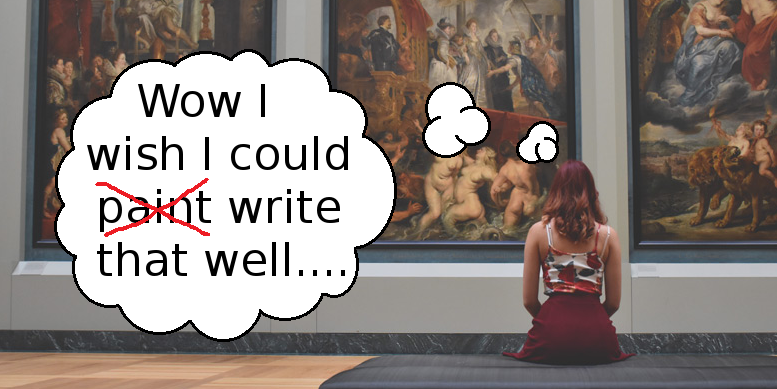Last week on Masterpiece Monday we looked at a character with a sexy voice (even though we never actually hear her say a word). This week I’d like to show off a great example of something that I find difficult to pull off well: writing action scenes.
Writing an action scene is tough. You have to keep tension high and fast-paced, but at the same time you need to provide enough details so your reader can follow what’s going on. But if you provide too many details, it just falls flat. It’s the writing equivalent of walking a tightrope… on a unicycle… taped to each foot.
One book that does action scenes very well is (unsurprisingly!) Harry Potter. Let’s take a look at one particularly great passage. It’s during Harry’s first broomstick-flying lesson, when Malfoy steals Neville’s Rememberall and is taunts Harry up in the air with it. Suddenly he throws it as far as he can, and we get this scene:
“Harry saw, as though in slow motion, the ball rise up in the air and then start to fall. He leaned forward and pointed his broom handle down – next second he was gathering speed in a steep dive, racing the ball – wind whistled in his ears, mingled with the screams of people watching – he stretched out his hand – a foot from the ground her caught hit, just in time to pull his broom straight, and he toppled gently onto the grass with the Rememberall clutched safely in his fist.”
This passage has a couple of great things going for it. First, it’s only two sentences long. The first sentence sets up Harry’s broomstick dive, and the second one carries us from his initial descent down to the very end.
Even though it’s a long sentence, it doesn’t feel long. The dashes break it up into easily readable pieces, and the lack of any full-stop periods makes us not slow down until the very end – just like Harry.
PROHARRYTIP #1: To keep the pace up in an action scene,
try subtracting the number of sentences.
Of course not every action scene can be just one long sentence; readers would get tired of it pretty quickly. However this passage does one other thing very well: verb usage.
Just a few excess words here and there can add up, quickly turning an intense scene into a molasses-y mess. But I love the snappy one-word verbs used in the above passage: pointed his broom handle, racing the ball, wind whistled, toppled gently, clutched safely, and more.
Imagine if the beginning were written like this instead:
“Harry saw, as though in slow motion, the ball rise up in the air and then start to fall. He shifted his body weight forward abruptly and gripped the point of his broom tightly to steer it downward – next second he was building up lots of increasing speed in a steep dive, at first following right behind the ball but then getting closer and closer until finally he was next to it….”
Yikes, that’s almost twice as long as the original. It’s more words, but it’s not any clearer for having used them. Condensing the long phrases into single verbs make for much faster reading, bringing us readers into the fast-moving scene more easily and effectively.
PROHARRYTIP #2: To keep the pace up in an action scene,
try subtracting long phrases/adverbs and replacing with single verbs.
Writing good action is tough. I know I struggle with it, but hopefully by looking at some good examples we can all try to imagine what doing exciting things must be like!
(Featured image via GAHAG, edited by me)

Comments are closed.